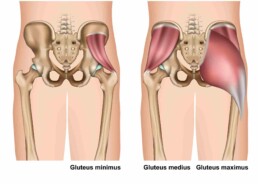The phrase “Pain in the Butt” is a slang reference to someone who is annoying, but it derives from a real medical problem: a pulled or torn muscle in the buttocks that can, indeed, be painful.
What Causes Pain in the Gluteal Muscles?
One of the major causes of buttocks pain is a strain – a tear to one of the gluteal muscles. This type of injury is often called a pulled butt muscle. A strain happens when the load placed on the muscle exceeds its normal boundaries. It can result when there is too much force or repetitive force during the muscle’s contraction. They are most likely to occur during exercise, especially sports that involve running or jumping.
A strain, or tear, to a gluteal muscle, may result in sudden pain after a fall or an exercise session. Chronic wear and tear can also lead to a strain in the glutes. Your muscles may experience fatigue if you aren’t properly conditioned to handle a specific exercise or motion or a strain may result if you don’t warm up adequately before exercise. In addition, poor technique can lead to gluteus strains.
The Gluteus Muscles Explained
Your buttocks are medically referred to as your gluteus and each buttock comprises three separate muscles: gluteus maximums, gluteus medius and gluteus minimus – along with fat. These muscles run diagonally from the pelvic rim toward the femur, or thigh bone. They exist in layers with the gluteus minimus being the smallest and deepest; the gluteus medius in the middle and the gluteus maximus the most superficial. The three muscles work together to stabilize the pelvis and allow for hip motion by contracting or shortening.

- The gluteus maximus is one of the body’s strongest muscles and is responsible for a leg extending backward. In one’s gait, it is crucial to pushing off and it is the muscle that allows you to straighten your hips when rising from a chair or ascending a flight of stairs.
- The gluteus medius muscle is responsible for the sideways movement of the leg (abduction) and in keeping your hips level when you move from side to side. It also helps steady your thigh bone when you run, jump or walk.
- The gluteus minimus muscle assists in sideways motion and internal rotation of the leg and helps the gluteus medius in stabilizing the hip and pelvis when one leg is lifted.
Symptoms of Buttock Pain
If the injury results from trauma, you may feel a sharp, sudden pain when it occurs. However, it will be most noticeable when you undertake activities that rely on the use of the affected gluteal muscle. Depending on the severity of the tear, your symptoms may include:
- A deep ache in your hip or buttock;
- Severe pain in the buttock;
- Difficulty climbing stairs;
- Unstable feeling in hips;
- Tingling and numbness in your buttock;
- Swelling or bruising in the hip and buttock area; and/or
- Sharp pain when squeezing your buttocks together.
Diagnosis and Treatment
If you experience gluteal pain and can pinpoint the time of an injury, be cautious for the first 48 to 72 hours. Rest is important. You may also want to ice the affected area using a bag of frozen peas or crushed ice wrapped in a damp towel. Apply the ice for 15 to 20 minutes each hour or two.
Until you receive treatment, it is important to proceed cautiously so the injury doesn’t worsen; avoid the temptation to stretch and exercise through the pain. This means avoiding certain motions and activities, such as sitting cross-legged or with your thigh crossed over; sitting in a deep chair; climbing stairs; and, of course, running or cycling.
You will also want to contact a licensed physiotherapist to assess your injury. A physiotherapist will stress and stretch your soft tissues, exploring the muscle strength, lengths, range of motion, flexibility and stability to determine the extent of the strain. They may ask for a diagnostic ultrasound, since this test shows soft tissues and tendons.
Your physiotherapist will start rehabilitation with movements involving the specific muscle before moving on to resisted movements, followed by activities that involve the muscle, such as climbing stairs. Then, you can transition to running and jumping activities. Exercises will focus on strength and range of motion.
It is important to treat a gluteal strain or pulled butt muscle, because if it doesn’t heal properly, it can recur and become a chronic problem. Generally, for a moderate tear, you can expect healing to take place within six to eight weeks. If the strain is a recurring one, it will take longer.
Take heart! With determination and treatment, you will no longer be the butt of jokes about your gluteal strain.
